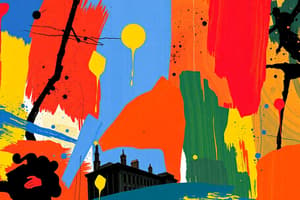Podcast
Questions and Answers
ما هو العنصر الأساسي في تصميم الأزياء؟
ما هو العنصر الأساسي في تصميم الأزياء؟
- النمط
- اللون
- الشكل
- الخط (correct)
ما هو نوع الأزياء التي يتم إنتاجها بالجملة وبيعها من على الرفوف؟
ما هو نوع الأزياء التي يتم إنتاجها بالجملة وبيعها من على الرفوف؟
- أزياء فاست فاشن
- أزياء ريتي تو وير (correct)
- أزياء لوكسري فاشن
- أزياء هاوتي كوتور
ما هو阶段 البحث والوحي في عملية التصميم؟
ما هو阶段 البحث والوحي في عملية التصميم؟
- المرحلة الأولى (correct)
- المرحلة الرابعة
- المرحلة الثالثة
- المرحلة الثانية
ما هو المبدأ الرئيسي لتنظيم تصميم الأزياء؟
ما هو المبدأ الرئيسي لتنظيم تصميم الأزياء؟
ما هو دور المصممين في صناعة الأزياء؟
ما هو دور المصممين في صناعة الأزياء؟
ما هو تأثير الثورة الصناعية على صناعة الأزياء؟
ما هو تأثير الثورة الصناعية على صناعة الأزياء؟
ما هو اتجاه الأزياء في العصر القديم؟
ما هو اتجاه الأزياء في العصر القديم؟
ما هو اتجاه الأزياء في القرن العشرين؟
ما هو اتجاه الأزياء في القرن العشرين؟
ما هو اتجاه الأزياء في الوقت الحالي؟
ما هو اتجاه الأزياء في الوقت الحالي؟
تتطلب ملابس الأطفال معاملة خاصة للعنایة بها
تتطلب ملابس الأطفال معاملة خاصة للعنایة بها
تثبت البطاقة الإرشادیة دائماً على خط خیاطة فتحة الرقبة للقطعة الملبسیة من الأمام
تثبت البطاقة الإرشادیة دائماً على خط خیاطة فتحة الرقبة للقطعة الملبسیة من الأمام
توضح البطاقة الإرشادیة نوع الخامات المستعملة في تنفیذ الملابس فقط
توضح البطاقة الإرشادیة نوع الخامات المستعملة في تنفیذ الملابس فقط
یجب عند اختیار خامات ملابس الأطفال مراعاة صعوبة العنایة بها
یجب عند اختیار خامات ملابس الأطفال مراعاة صعوبة العنایة بها
ملابس الأطفال لا تتعرض لسرعة الاتساخ
ملابس الأطفال لا تتعرض لسرعة الاتساخ
يتطلب البطاقة الإرشادیة كتابة مسمى الثوب عليها دائما.
يتطلب البطاقة الإرشادیة كتابة مسمى الثوب عليها دائما.
رمز المنقطة على المكواة عبارة عن درجة حرارة مرتفعة.
رمز المنقطة على المكواة عبارة عن درجة حرارة مرتفعة.
یجب إزالة البطاقة الإرشادیة من الثوب عند شراء القماش.
یجب إزالة البطاقة الإرشادیة من الثوب عند شراء القماش.
اللون الأحمر على الرموز اللونیة یعني توخي الحذر في الغسیل.
اللون الأحمر على الرموز اللونیة یعني توخي الحذر في الغسیل.
رموز التجفیف یشیر إلى استخدام المجفف الكھربائي فقط في التجفیف.
رموز التجفیف یشیر إلى استخدام المجفف الكھربائي فقط في التجفیف.
Flashcards are hidden until you start studying
Study Notes
Design
- Elements of Design:
- Line: shape, direction, and movement
- Shape: geometric and organic forms
- Form: 3D shape and volume
- Texture: surface quality and visual interest
- Pattern: repetition of design elements
- Color: hue, saturation, and value
- Principles of Design:
- Balance: visual equilibrium
- Proportion: relationship between design elements
- Emphasis: focal point and visual hierarchy
- Harmony: visual cohesion and unity
- Contrast: visual interest and surprise
- Design Process:
- Research and inspiration
- Sketching and ideation
- Prototyping and refinement
- Production and manufacturing
Industry
- Fashion Cycle:
- Design and production
- Marketing and promotion
- Distribution and retail
- Consumption and feedback
- Industry Segments:
- Haute Couture: high-end, custom-made clothing
- Ready-to-Wear (RTW): mass-produced, off-the-rack clothing
- Fast Fashion: affordable, trendy, and quickly produced clothing
- Luxury Fashion: high-end, premium clothing and accessories
- Key Industry Players:
- Designers and design houses
- Manufacturers and suppliers
- Retailers and distributors
- Models and influencers
History
- Ancient Civilizations:
- Egyptians: emphasis on luxury and ornamentation
- Greeks and Romans: draped fabrics and classical styles
- Chinese: silk production and intricate designs
- Middle Ages to Renaissance:
- Medieval Europe: sumptuary laws and social hierarchy
- Renaissance Italy: revival of classical styles and ornate decoration
- Modern Era:
- Industrial Revolution: mass production and new textile technologies
- 20th century: rise of haute couture, ready-to-wear, and fast fashion
- Contemporary fashion: global influence, sustainability, and diversity
Studying That Suits You
Use AI to generate personalized quizzes and flashcards to suit your learning preferences.




